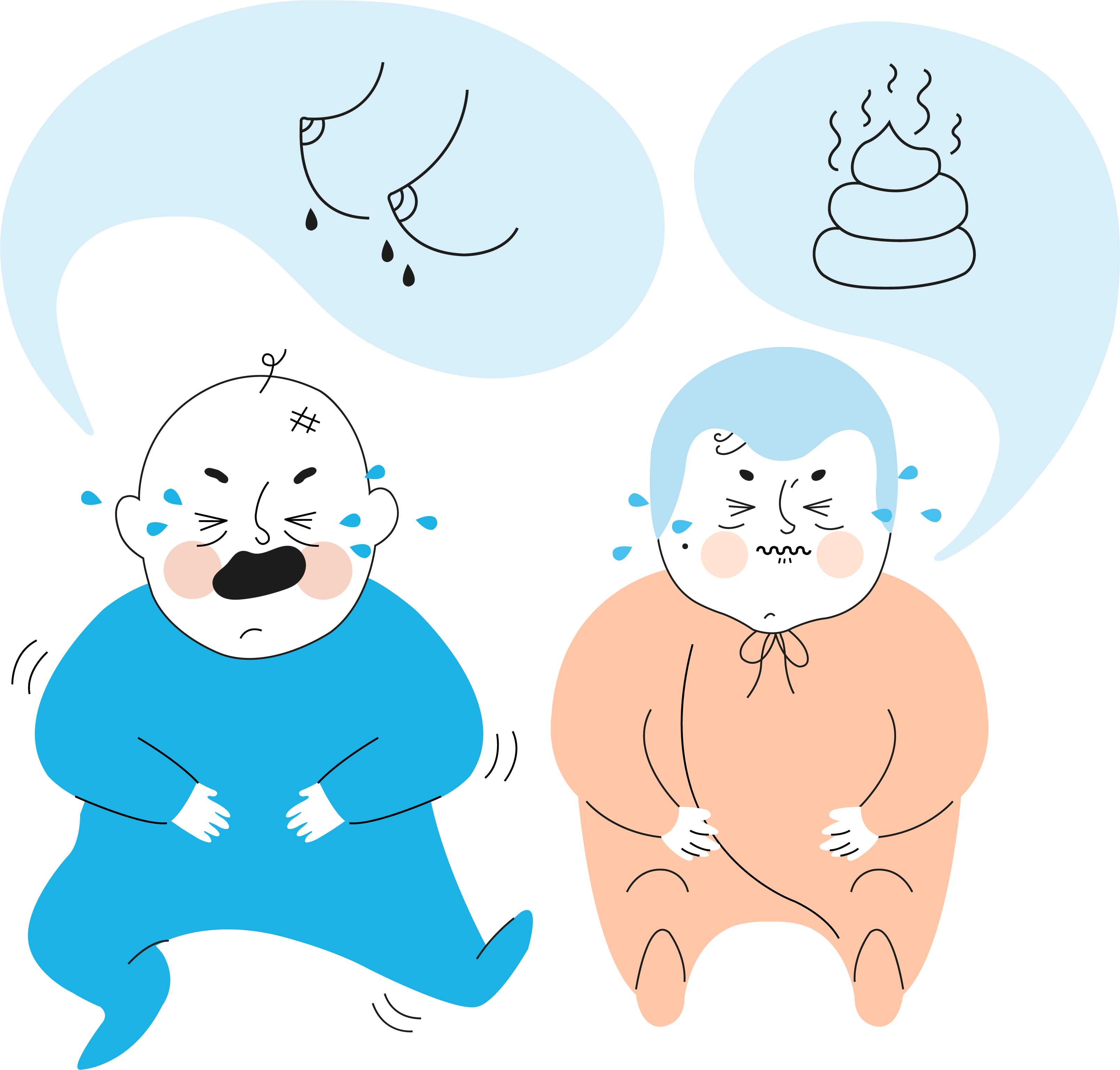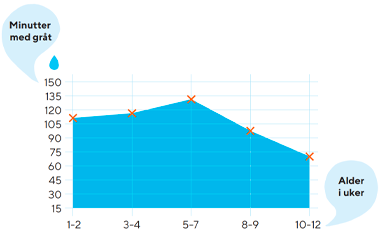Tips 5
Infants cry to get help

Crying is a baby’s way of communicating. They cry to tell you that they need help. Feel your way – you’ll eventually become an expert on what your child needs.
If a crying baby makes you so cross or stressed that it’s difficult to think straight, put your child gently in a safe place for a few minutes. Use this time to relax before you try to console it again. Ask for guidance at the health centre if it happens several times.
Babies cry to survive and to get us to react. Crying is their way of telling us that they’re hungry, in pain, need comforting or something else which means they need an adult who can help. When they get that help through consolation, food, play and comforting, the bond between baby and adult is strengthened and the child feels secure. A baby sometimes cries even if we’ve done all we can to console it. It’s normal then to feel despair and frustration. We don’t plan to harm our child, but things sometimes become so stressful that we lose control and act in anger. Shaking a child is extremely dangerous. It can cause serious harm to head and neck and, in the worst case, kill the child or leave it with lifelong damage. If you find it difficult to think straight, the sensible course could be to put your child gently in a safe place for a few minutes. Use this time to relax before you try to console it again.
Being born is a big transition. The baby suddenly has to breath, eat, digest, wear clothes and absorb numerous sensory impressions. Many people call the first three months “the fourth trimester”. This is often a tough time not only for the baby but also for the newly fledged parents – both mother and father. Hospital and health centre personnel can help you to understand your baby’s body language and why it’s crying. Parents are the most important people in a child’s life, and you eventually become an expert in what your baby needs. Feel your way – and ask for help if you need it.
All infants are different, and vary in their crying patterns. It is normal for crying to increase over the first six weeks. At peak, the baby normally cries for two hours and 15 minutes a day on average. After six weeks, crying gradually reduces and is down to an average of one hour and 10 minutes a day by week 12.

Colic is an extreme variant of normal baby crying – a condition of inconsolable, intense and high-frequency weeping experienced during the first few months of life. It is very common, and occurs with 19-40 per cent of all newborn babies. Crying often starts in the afternoon/evening, and begins and stops suddenly. The child appears to be in pain – drawing up its legs, getting red-faced and tensing its body. The crying sessions last for at least three hours daily, three days a week, and over a period of at least three weeks. Colic has no single cause. The condition is often characterised by a combination of several factors which unleash crying. A detailed medical examination is important in order to rule out illness or a food allergy, for example. If the symptoms continue after the baby is more than four months old, or other symptoms occur, a medical investigation will be important.
Following the birth, the baby should be breastfed often and let the baby decide how much the baby wants to eat. It varies among babies how many meals it needs, and the meals can quickly overlap each other. In the beginning, it is common to have 8 to 12 meals or more a day. The meals will gradually become fewer, but larger. The number of wet nappies per day is useful information to detect whether the child gets enough milk or not. Check here for further guidance or ask at the health station if you are in doubt.
The more often you breastfeed, the more milk you produce. Most breastfed babies will need night meals for a longer period. It is especially effective in increasing milk production because your body has more of the milk-producing hormone prolactin at night.
When using a bottle, the feeding should mimic the way milk flows during breastfeeding. This is called paced bottle feeding and gives the child time to signal that the baby is full. Read more about bottle feeding at Helse Norge or Ammehjelpen. Always contact your health nurse or local emergency room if you are in doubt.
Babies cry a lot to begin with, usually reaching “peak tears” at around six weeks. After 12 weeks, most of them weep much less. Although no miracle cure exists, there are a lot of things you can try to reduce the crying. After a while, this clicks into place automatically. The checklist below provides general guidance, and is not intended to replace the advice you get from a doctor or health visitor. Start at the top and work your way down.
Hungry?
Check whether the child is hungry. Try to breastfeed or give it a bottle. Babies younger than four months old need feeding every two-four hours around the clock. All infants have periods of the day when they feed more frequently.
Dirty nappy?
Check and change as required.
Wind?
Many babies have problems with wind (air trapped in stomach and intestines). That can be painful. Here are some important tips:
Create calm conditions for feeding, take plenty of time and make sure the baby doesn’t drink too much too quickly. Hold the baby’s head higher than their stomach, and take two-three breaks for burping. Babies being breastfed should finish with one breast before starting on the other, and be burped in between. Babies being bottle-fed must suck the milk in and the teat should not have too large a hole. Hold the bottle horizontally and keep the teat up towards the palate. To relieve wind, the baby can be held upright while stroking its back. Careful stomach massage is a fine technique for getting the baby to break wind.
Need for closeness?
The baby needs you in order to feel secure. If it can’t see or feel you, it doesn’t understand that you’re near at hand. Many parents enjoy using a baby carrier or slings. Babywearing is a great way to hold and comfort your baby while keeping your hands free.
Tired, stressed or over-stimulated?
Babies often cry when they’re tired, stressed or over-stimulated. Infants may be different, but they all need a lot of sleep and rest. A newborn baby needs to sleep an average of 13-17 hours per day. They often get tired after being awake one-two hours. There’s no ready solution for getting a baby to calm down or go to sleep. Some people tuck their child in, while others take it for a walk in the pram or a trip in the car. Other children are calmed down by sounds like a vacuum cleaner, running water or a trusted adult saying “shhhh” and lulling it to sleep.
Pain?
Check whether the baby appears to be uncomfortable. Take its temperature and see if its nappy or clothes are too tight, or if hairs have become wound around its fingers, toes or genitals. Should the amount of crying be unusually high, or you fear this could be due to illness, you must see a doctor.
Food intolerance or allergy?
If the mother is breastfeeding, her consumption of nicotine or a lot of caffeine can reinforce crying. Some babies react to eggs, milk, nuts or wheat. In consultation with a doctor, the mother can try to cut out such foods one by one for a week at a time to see if that helps. In some cases, babies receiving replacements for mother’s milk may have an allergic reaction. Contact your doctor and ask for advice.
How much support and comforting a baby needs to calm down varies. Sometimes it’s enough that the child sees you so that it knows you’re there. At other times, maximum support such as a dummy (pacifier) and lulling may be needed to end the crying. Feel your way to see how much comforting your baby needs on different occasions. It will then eventually learn that Mummy and Daddy help when things are difficult. You’ll work this out together. The “comfort stair” can be a great help here. See the guidance and film below.
A 24-hour clock is a tool for recording when a baby is asleep, awake, restless and crying. This can be a useful aid if it proves difficult to establish a good daily rhythm, and crying dominates much of the day. Logging your baby’s daily rhythm for a few days can make it easier for health personnel to help you find a good solution.
This involves drawing the day as a clock face, divided into 15-minute segments. Each of these can be coloured red for crying, blue for sleeping, yellow for restlessness and so forth. Other activities, like eating or changing diper, could usefully be entered here. You’ll find an example of a day clock in the 10 smart tips for all parents of young children guide, use the digital versjon which is available here (in Norwegian), or you can print it out from the www.foreldrepakke.no website.
At any time
When a baby less than four months old has a temperature above 38°C, has an injury caused by you, by others or by accident, cries continuously for more than two hours, refuses to drink milk over many hours, vomits violently, has dry nappies, has blood in their vomit or excrement, or behaves abnormally.
A newborn baby must be assessed by a doctor if it is suspected of having a fever or its general condition has deteriorated. Its general condition reveals something about its overall health. A deterioration could be a symptom of illness, and involves a decline in physical and/or mental health with symptoms and signs which could include tiredness, feeling ill, loss of weight, lack of appetite, reduced consciousness, distress and so forth.
In normal clinic hours
When the baby vomits/regurgitates a lot after feeding, has diarrhoea or problems digesting food, if you are worried about it, or are unable to meet its needs, when the child is more than four months old, still cries a lot and seems unhappy, or when the baby fails to put on enough weight.
Foreldresupport (Parental Support) is an 24-hour telephone help line and chat service for caregivers who need help, guidance or air their thoughts. The service is established in collaboration with Mental Health and Stine Sofies Stiftelse. See Foreldresupport.no or call 116 123 (press key 2) to contact service.
Babies usually cry the most in their first six weeks of life. After 12 weeks, most usually cry a lot less. Babies sometimes cry even though you’ve done all you can to console them. It’s normal then to feel despair and frustration. This doesn’t mean you’re a bad parent or that you’ve got a difficult child.
Innholdet på denne siden er utviklet i samarbeid med Tone Emilie Løvjomås Spinnangr, spesialsykepleier og fagrådgiver i Stine Sofies Stiftelse. Norsk barnelegeforening har gjennomgått teksten og stiller seg bak innholdet under tips 5.
· De minste barnas stemme, (2015) byMette Sund Sjøvold og Kristin G. Furuholmen
· En bedre start- for deg og din baby (2012) by Inger Pauline Landsem og Stig Brøndbo
· Vurdering av nyfødte barns adferd (2013) by T. Berry Barazelton og J. Kevin Nugent
· The Happiest Baby on the Block (2002) by Harvey Karp
· Systematic Review and Meta-Analysis: Fussing and Crying Durations and Prevalence of Colic in Infants. (2017) Wolke D et. al.
· Website: www.uptodate.com (2019) Infantile colic
· Website: helsestasjonstjenesten.no (2019) Gråt og trøst (run by Spedbarnsnettverket and RBUP Øst og Sør)
· Pediatric guidance: https://www.helsebiblioteket.n...
Eight steps for comforting (Trøstetrappa)
Eight steps for compforting (Trøstetrappa) was introduced by Inger Pauline Landsem in her book En bedre start - for deg og din baby.
The term comfort referes to the following litterature:
- Website: helsestasjonstjenesten.no (2019) run by Spedbarnsnettverket and RBUP Øst og Sør
- Book: Vurdering av nyfødte barns adferd (2013) by T. Berry Barazelton and J. Kevin Nugent
- Book: En bedre start- for deg og din baby (2012) by Inger Pauline Landsem and Stig Brøndbo
Soothing/comforting
When a child has its needs for comfort, food (nutrition), play and cuddling fulfilled, the child feels safe and the connection between parent and child streghtens. The child understands that it can trust and rely on the adult and it helps to cry for help. If the child is struggling with finding calm after its fed and suppose to sleep, swaddling is a good technique to try out. Use a thin swaddling blanket and put the child on its back when it is going to sleep. It is the hands that are supposed to be swaddled to the childs body, the legs should move freely. Swaddling can be used on children up to the age of about 3-4 months. Don’t swaddle a child that can turn over from back to stomach or vice versa.
Burp
There are many reasons why babies swallows air. Excessive air in the belly can give the baby uncomfort and pain. Ask your helsesykepleier about advice if you are uncertain if your baby swallows to much air when it is feeding. In the film you will get some tips about how you can help your baby burp.
Wind and gas/fart
It is important that the child is awake when massaging it and that it perceives it as OK. If it gives you signals that it is unconmfortable or cries, you stop and comfort. Abdominal massage/ belly massage as shown in the film can be done up to 2-3 times a day in a calm and tempered room. After feeding, you should wait about 30 minutes to prevent gulping. Take some neutral body oil in the palm of your hands and warm it. You can begin with massage early on, but avoid the bellybutton in the beginning. Use soft strokes with one hand in the beginning.




